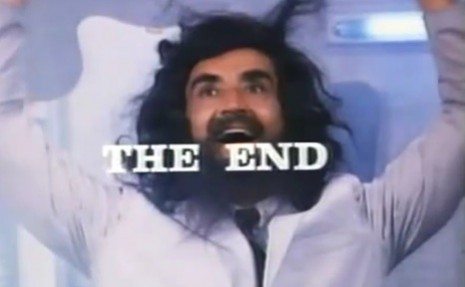
Dangerous Minds pal, Simon Wells, author of the excellent biography Charles Manson: Coming Down Fast, sent this rather bizarre link to the finale of Sharon Tate’s rarely seen last film The Thirteen Chairs (aka 12 + 1) - an Italian comedy about a hairdresser searching for a missing inheritance hidden inside a set of chairs. However, it’s not the film’s plot that is intriguing, but the eerie freeze frame at the finish, which as Simon points out:
...is just weird. Sharon Tate’s last film: The Thirteen Chairs- shot just six months before her diabolical end. The final credits sequence: I will say no more that just watch it. Talk about creepy prophesies over “The End”. I am amazed this hasn’t been highlighted before. So very odd.
It certainly is odd, especially as co-star, Italian actor Vittorio Gassman, who played the well-groomed hairdresser, is suddenly turned into a demented long-haired hippie, with an uncanny resemblance to Charles Manson.
Make of it what you will.
With thanks to Simon Wells
Previously on Dangerous Minds

Directed, written and acted by teenagers Charlie Davis, David Williams and Jimmy Robinson, 1967’s The Jungle chronicles the exploits of Philadelphia’s 12th and Oxford street gang. It is amateur film making that transcends its limitations and achieves a certain rough artfulness.
With its starkly poetic black and white cinematography, urban rhythm and streetwise jargon The Jungle recalls Shirley Clarke’s The Cool World and the Beat-era improvs of Cassavetes’ Shadows. The fact that theThe Jungle holds its own against some of the periods more legendary indie films makes it somewhat disappointing that none of the people involved with the production of the film went on to make more movies.
There’s little info on the internet regarding The Jungle, but the I found the following comment from Youtube compelling:
This film (The Jungle) was shown along with slide shows of dead teens on slabs in the 70’s in schools around Philly to try to stop the gang violence at that time. In the early ‘70s, Philly led the nation in gang-related deaths at around 40 a year.
Death Row inmate, Philly gang member and writer Reginald S. Lewis recalls the Oxford Street gangs:
I saw the 70’s usher in the era of blackploitation flicks such as Superfly, The Mack, Come Back, Charleston Blue, and even slickly packaged Hollywood gangster movies like The Godfather. This was also an era that bred hustlers-turned-authors IceBerg Slim and Donald Goines, and some of the most ruthless true-life gangsters this country has ever seen.
In my hometown, Philadelphia, Pennsylvania, vicious black street gangs seemingly ruled every inch of the black community, and it was a dangerous time to be a young black teenager living in the treacherous terrain of the urban wilds. My parents did all they could to keep my two older brothers and me from being drafted into the notorious “12th & Oxford Street Gang,” one of the largest, fiercest black youth gangs in the history of Philadelphia.
The Oxford Street gang had well over 500 members, divided into gradations and ranks, according to age. There were the “Pee Wees,” “The Midgets,” “The Juniors,” and “The Seniors,” and “The Old Heads.” There was also 8th & Oxford, 15 & Oxford, and “Uptown Oxford Street,” which was 20th Street, and beyond. These divisions boosted the ranks into thousands.”
Teenage wasteland, Philly-style.
Part two of The Jungle after the jump…

Tonight’s feature presentation, ladles and gentlespoons, is Frankenstein, Edison Studios’ 1910 production of Mary Shelley’s novel The Modern Prometheus. Directed by J. Searle Dawley and starring Augustus Phillips, Mary Fuller and Charles Ogle as the monster.
This was the first ever movie production of Frankenstein, filmed over 3 days at the Edison Studios in the Bronx, New York. For many years it was thought this film was lost, only a few lobby cards, stills and posters were thought to exist, that was until the early 1950’s, when a print of the film was purchased by Alois F. Dettlaff, a movie collector from Wisconsin. However, Dettllaff didn’t realize the rarity or value of his latest possession until the 1970s, when he had it preserved on 35mm. Though the film had deteriorated, it was still viewable, and had its original caption cards and beautifully hand-tinted sequences.
This version of Frankenstein differs from Shelley’s novel but does touch on some of the themes implicit in her novel. The one thing that has always struck me about Shelley’s tale is the absence of love. It is pointed to throughout the narrative by negatives, from the very creation of the monster, to its lack of a name, to Frankenstein addressing it as “hideous”, “loathsome”, “deformed”. Though the doctor may feel pity for his handiwork, he cannot look at it without seeing “the filthy mass that walked and talked,” which fills him with “horror and disgust.” Talk about absentee fathers.
The creature having failed to win the love of his creator, seeks it in the outside world, when this fails, he realizes he must he have Frankenstein make him a partner. The doctor reluctantly agrees, and starts his preparations on the isle of Orkney. Unfortunately, for the monster, Frankenstein has a change of heart, fearing a world populated by monstrous off-spring, and destroys his second creation. When this happens, you know it’s going to end in tears, as the monster claims vengeance on his maker.
In this film version, the snaggle-toothed monster with the Russell Brand hair is similarly desperate for love, and behaves as a jealous lover for Frankenstein’s affection. But what is more intriguing is the suggestion the monster is not so much real but an element within Frankenstein’s nature, an idea Mary Shelley may have agreed with, for who is Victor Frankenstein? other than a portrait of her husband Percy Bysshe Shelley, and the monster? But a metaphor for their love?
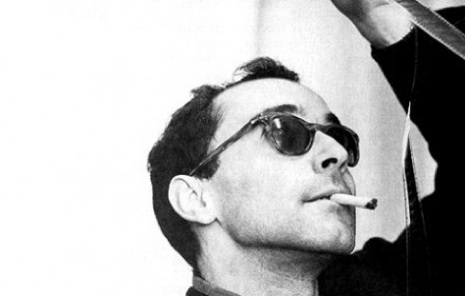
“I am not interested in making political films but in making films politically”-Jean-Luc Godard
“All you need to make a film is a girl and a gun”—Jean-Luc Godard
“I believe a film should have a beginning, a middle and an end, but not necessarily in that order.”
Happy birthday, Jean-Luc Godard! The great French “New Wave” director turned 80-year-old today. Godard, one of the most important film directors and theoreticians of French post-war cinema was recently given a special honorary Oscar award, but this was not without controversy in certain quarters. The idea that the Academy of Motion Picture Arts and Sciences thought he’d show up to accept it—I don’t even think he acknowledged it—is ridiculous in the extreme.
Below, his wild, seldom-seen anti-capitalist screed, British Sounds a.k.a. See You at Mao (US title) a short film made for, but never broadcast by, London Weekend Television, in 1969. When Godard toured American college campuses in the 1970s, this was often the film he screened at his lectures. I recommend that you forward to the next scene if you start getting bored. It’s a neat film, but even 40 years ago, this would have difficult to watch straight through. Parts of it are more interesting than others (something that can be said of many Godard films, of course!)
More Godard after the jump, including the classic grocery store rampage scene from Tout Va Bien with Jane Fonda.
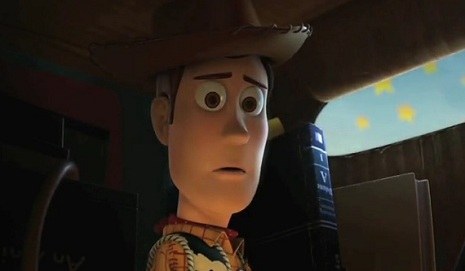
Toy Story vs. Fight Club including The Pixies ‘Where Is My Mind’.
I know, I know, these movie mashups are starting to get tired, but this one is inspired in my opinion.
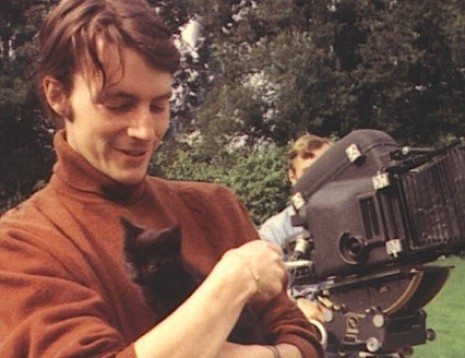
Michael Reeves was just twenty-four when he wrote and directed Witchfinder General. It would prove to be his most critically acclaimed and successful film, and would also be his last. For Reeves died not long after the film’s release from an accidental overdose - a tragic demise for a director of such immense talent, who had proven himself with three distinct horror films: Revenge of the Blood Beast, The Sorcerers and Witchfinder General (aka The Conqueror Worm).
Reeves’ precocious talent and early death led to a mythologizing of his life. The film writer David Pirie likened him to the Romantic poets Shelley, Byron and Keats, and as his death came at the end of the sixties, there was the inevitable twinning with the untimely deaths of troubled rock musicians, such as Jimi Hendrix and The Rolling Stones’ Brian Jones. Add to this the belief that Reeves may have killed himself, then we have the beginning of a cinematic legend - which is all good copy, but sadly removes the man from his art.
Reeves was precocious, he made his first film at the age of 8. Whether the resulting home-movie was good or bad is irrelevant, for what is important here is the realization of Reeves’ youthful ambition. At school he met and became friends with Ian Ogilvy, who went on to become an actor and star of all his films. From school, Reeves traveled to Hollywood at 16, where he door-stepped Don Siegel, director of Invasion of the Body Snatchers. Siegel was Reeves’ favorite director, and let’s be frank, it takes balls to turn up at someone’s door and convince them, then and there, that they need to employ you. Siegel was convinced and gave Reeves a job as his assistant - now, there’s a lesson here we all can learn from. Working for Siegel gave Reeves the opportunity to make the contacts and raise the cash for his own first feature film, Revenge of the Blood Beast, which starred Ogilvy and horror queen Barbara Steele. The film was well regarded and if not exactly brilliant, it marked the arrival of a new and original cinematic vision, and as with all young film-makers, there was soon the predictable murmur of Reeves being the next Orson Welles. Nice thought, but not exactly correct.
Two years later, in 1967, Reeves made his first important horror film, The Sorcerers, a trippy slasher which starred Ogilvy and film legend, Boris Karloff, who was at a stage of making many strange and often dreadful films, but had this time, as he did later with Peter Bogdanovich’s Targets, made a wise choice by agreeing to star in Reeves’ film. While Post-Modernism has made it easy to intellectualize anything, it is fair to say that in this case there is enough meat on this film’s bones to justify a more rigorous examination. The Sorcerers is more than a horror film, it has a subtext about voyeurism and cinema, and questions the cultural obsession with youth. The movie, and especially Karloff’s association with it, propelled Reeves into the top rank of British film directors, which saw him listed as the-man-most-likely-to, alongside the older and more experienced film-makers Ken Russell, Lindsay Anderson and Ken Loach. Don’t forget, at this point, Reeves was just 23.
But it is Witchfinder General that is Reeves most important and best film, a grisly horror that starred Vincent Price, Ian Ogilvy, Rupert Davies, Hilary Dwyer and Patrick Wymark.
The film had depth as it was based on the true story of Matthew Hopkins, the self-appointed Witchfinder General, who carried out the torture and execution of alleged sorcerers/witches during the English Civil War, in the 1640s. Hopkins was a notorious figure who made a fortune out of his activities, being paid roughly two bucks for every soul he saved by hanging, burning or drowning.
Vincent Price was brilliant as Matthew Hopkins, for Reeves had coaxed a more measured performance from the usually “camp and hammy” film star. The story goes Price was so annoyed by Reeves continual directions to underplay that one day he turned on Reeves and said, “I have made 84 movies, how many have you made?” To which Reeves replied, “Two good ones.” Price laughed, and thereafter, did as he was told. Of course, this may be apocryphal for, as years later, Price talked about his unhappiness in working with Reeves:
Well he hated me. He didn’t want me at all for the part. He wanted some other actor, and he got me and that was it. I didn’t like him, either, and it was one of the first times in my life that I’ve been in a picture where really the director and I just clashed [twists his hands], like that. He didn’t know how to talk to actors, he hadn’t had the experience, or talked to enough of them, so all the actors on the picture had a very bad time. I knew though, that in a funny, uneducated sort of way, he was right in his desire for me to approach the part in a certain way. He wanted it very serious and straight, and he was right, but he just didn’t know how to communicate with actors.
Hindsight is a great thing, and Price has the upperhand here, able to score points after the director’s dead and the film has been highly praised. Whatever the disagreements between the two on set, Reeves got Price to deliver one of his best cinematic performances.
The film’s release captured the public’s imagination, as many saw Witchfinder General‘s barbarism as a damning comment on the Vietnam War. Despite criticisms of the film’s shocking, documentary-like violence, Witchfinder proved to be Reeves biggest commercial success.
Yet after it, Reeves seemed to lose his way. He became unraveled, started to drink heavily, medicated himself with uppers and downers, and started a slow spiral into depression. Those who were witness to this give different accounts: some, the strain of working with Vincent Price; others, a failed romance; others still, Reeves’ nihilism. When visiting the composer Paul Ferris in hospital, where Ferris was recuperating from his own failed suicide attempt, Reeves joked, which between the two would be first to succeed in killing himself?
In February 1969, Reeves returned home after a night’s drinking, and swallowed a handful of anti-depressants. Whether intentionally or not is open to conjecture, but what’s known is Reeves died in the early hours of the 11th February from an overdose of barbiturates - his death robbed British film, and the horror world, of one of its most brilliant and original talents.
Parts 2 & 3 on Michael Reeves plus bonus trailer after the jump…

One of the funniest human beings to ever walk the earth Marty Feldman died 28 years ago today. He was only 49. Heart attack.
Dream sequence from the 1970 British comedy Every Home Should Have One starring Marty Feldman. Animation by Richard Williams.
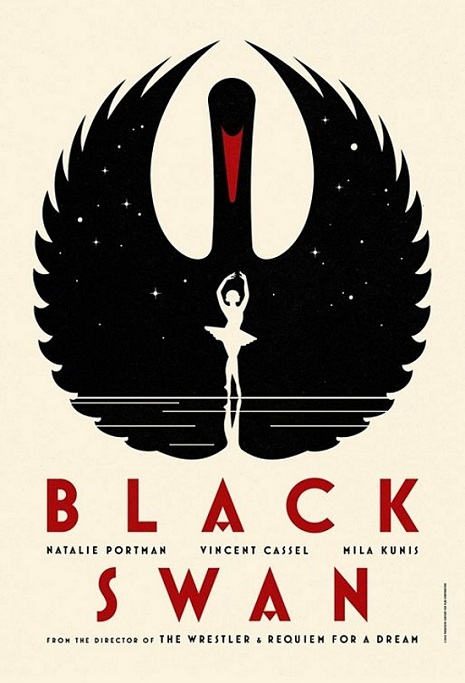
It’s been well over a month since I saw The Black Swan at The Austin Film Festival and the movie has been dancing in my brain ever since. In my review of the film for Dangerous Minds I praised its delirious fusion of the luridly psychedelic shocks of Dario Argento and the Technicolor spectacle of Michael Powell’s The Red Shoes. I could have and should have compared The Black Swan to the great Hammer Films and Corman’s A.I.P. Edgar Allen Poe flicks. The mere fact that I’m mentioning producers of classic horror films that haunted my youth, is testimony to the crafty genius of director Darren Aronofsky and his cinematographer Matthew Libatique. The Black Swan earns its place alongside such venerable masterpieces of spooky atmospherics as Argento’s Suspiria, De Palma’s Sisters, Terence Fisher’s Dracula Prince Of Darkness and Roger Corman’s The Masque Of The Red Death. It’s that good.
Natalie Portman’s deeply nuanced, physically challenging performance is already the stuff of legend and she’ll undoubtedly receive all kinds of nominations and awards in the next few months.
From my review of 10/27/2010:
It’s rare for a film these days to actually be scary. Most contemporary horror flicks are repulsive rather than frightening, assaulting the viewer instead of seducing them. The Black Swan is jump-out-of-your-seat scary and it achieves its scares honestly, through evocative storytelling and crafty film making. In addition, it’s sexy as hell, full of gothic atmosphere and genuine eroticism - a fairytale for adults.”
The Black Swan opens nationwide tomorrow (Dec. 3). By all means see it. It’s number 9 on my top ten films of 2010.
Previously on DM: Aronofsky channels Argento in gothic thriller ‘The Black Swan’
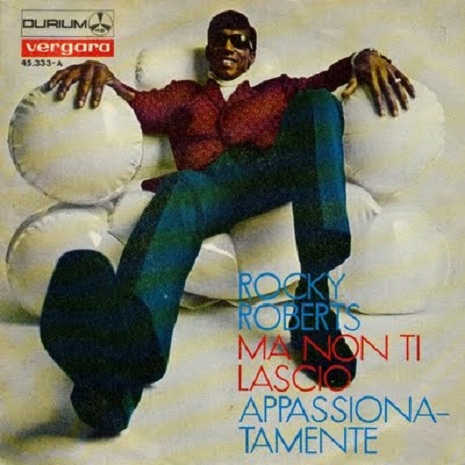
Rocky Roberts (Charles Roberts) was a onetime professional boxer turned singer who, along with his group The Airedales, helped introduce soul music to Italy in the 1960s.
Roberts got his start as the frontman in South Florida dance band Doug Fowlkes & The Airdales. But, it wasn’t until Fowlkes and Roberts joined the Navy and ended up in Europe that they encountered success as Rocky Roberts and The Airedales. Discovered by popular Italian deejays Gianni Boncompagni and Renzo Arbore, Rocky and his group became over-night stars. Rocky’s fluid dance moves and groovy fashion sense was a big hit with Italian teenagers.
In 1963, The Airedales disbanded and Rocky continued to produce hits as a solo act. Along with Stevie Wonder and Wilson Pickett, Roberts was the most famous Black singer in Italy during the mid-to-late sixties.He became a popular attraction on Italian television and even starred in a couple of movies. He sang the English version of the title track of spaghetti western classic Django. His popularity spread across the Continent to include France and Britain.
Roberts returned to the USA for awhile but eventually returned to Italy where he continued to perform up until his death in 2005 in Rome.
In Britain, his song ‘Just Because Of You’ was a hit among fans of mod soul and still gets played at Northern Soul all-niters.
While dripping with sartorial coolness, Rockey’s trademark sunglasses were not just for show. They covered up scar tissue around his left eye acquired doing his old boxing days.
Rocky’s bandmate Jerry Armstrong recalls the early days…
[...] we formed the group while serving in the U.S. Navy at Boca Chica Naval Air Station, Key West Florida. We first practiced in the old base theater, beginning our trek in 1958. In 1959 we were transferred to the U.S.S. Independence, CVA-62 (Aircraft Carrier) and served aboard her until we were all discharged in 1962. We made two trips to Europe on the Indy and during the first trip entered a rock and roll contest in France and won first place. Eddie Barclay, the International Banker, saw us and liked us and signed us to a recording contract with his Barclay Records label. We later recorded for ATCO in New York City. While the band did well up and down the East Coast of the U.S. from Key West to New York City, we were most popular in Europe, with France, Greece, and Italy being countries that most favored our music. We cut several albums and EPs. In 1963, the band split and members went separate ways. Roberts took the band’s name and went back to Europe where he did very well in the music business with new members.
Here’s a little compilation of Rocky on film and video. It includes some footage with Jayne Mansfield from The Wild, Wild World of Jayne Mansfield and the theme song from Django.